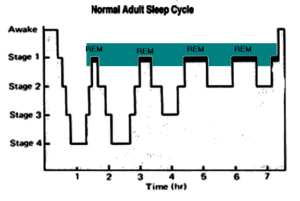Sleep is necessary for us to clear the toxin called beta-amyloid and tau proteins in the brain. Improper sleeping position can cause of back pain, neck pain, stomach troubles, and even premature aging. Sleep helps our brains sort out, reorder and make sense of all the information it consumes during the day. Researchers are telling us that sleeping less than six hours per night can actually shut down some genes, that play a key role in the body’s process of self-repair. Sleep plays a significant role in brain development. It is impossible to overcome sleep deprivation through any other recovery method. Sleeping in the same position night after night can itself create pain in neck and shoulder. One position all night is also not good for blood circulation. We need to change our positions, at least three to five times per night.
Researchers are telling us that sleeping less than six hours per night can actually shut down some genes, that play a key role in the body’s process of self-repair. Sleep plays a significant role in brain development. It is impossible to overcome sleep deprivation through any other recovery method. Sleeping in the same position night after night can itself create pain in neck and shoulder. One position all night is also not good for blood circulation. We need to change our positions, at least three to five times per night.
Yoga tells us that you should sleep on the left side of your body for 50% of your sleeping time and rest of the time you should change your position. For proper sleep, you must choose a mattress that isn’t too hard or too soft. Something that conforms to your body without creating pressure points works best. And surrounding yourself with multiple pillows usually helps. You can use full-length body pillow between your knees. Getting comfortable when you sleep is important because a lack of sleep can cause joint inflammation and lowers your pain threshold. It’s important to use a pillow to keep your head in a neutral position, so your head won’t drop and affect your posture.
Sleep Cycle:
 There are five distinct phases of sleep. We pass from wakefulness through the sleep phases in a very orderly pattern. One sleep cycle takes about 90 to 120 minutes, thus for an average sleep time of eight hours, there will be a four to five complete sleep cycles. The sleep cycle begins with four-stages of non-rapid eye movement (Non-REM) sleep. After completing the first fourth stages, instead of continue to fifth REM sleep the four stages quickly reversed and then followed by REM sleep. The REM sleep will occur roughly after 90 minutes of falling asleep, and it will last only for about 10 minutes. The steps of sleep are: Stages 1, 2, 3, 4, and REM. Stage 4 is actually the deepest period of sleep. If you wake up out of stage 4, you are likely to be disoriented, groggy, and even have a headache. After REM sleep, the whole cycle begins again. The brain is very active during REM sleep. REM sleep is when we do most of our dreaming. We are fascinated by dreaming.
There are five distinct phases of sleep. We pass from wakefulness through the sleep phases in a very orderly pattern. One sleep cycle takes about 90 to 120 minutes, thus for an average sleep time of eight hours, there will be a four to five complete sleep cycles. The sleep cycle begins with four-stages of non-rapid eye movement (Non-REM) sleep. After completing the first fourth stages, instead of continue to fifth REM sleep the four stages quickly reversed and then followed by REM sleep. The REM sleep will occur roughly after 90 minutes of falling asleep, and it will last only for about 10 minutes. The steps of sleep are: Stages 1, 2, 3, 4, and REM. Stage 4 is actually the deepest period of sleep. If you wake up out of stage 4, you are likely to be disoriented, groggy, and even have a headache. After REM sleep, the whole cycle begins again. The brain is very active during REM sleep. REM sleep is when we do most of our dreaming. We are fascinated by dreaming.
Normal Sleeping Positions
There are four basic sleeping positions: left-side, right-side, on-back and on-stomach. About sixty percent of Americans sleep on their side. Only 14% sleep on their back and 16% on their stomach. Which way is best? Every position have their own advantages and disadvantages.
Sleeping in the same position night after night creates problems. Consistently compressing the body on one side or stretching another side over time can create an imbalance and result in pain in that area. To avoid pains, you need to change your sleeping positions.
Sleeping on Back:
Sleeping on the back prevents facial wrinkles because nothing is pushing against your face. However, lying flat on your back, may be good for the lower back but can create digestive and breathing problems. Back sleeping is associated with snoring because while you are on your back, your tongue moves back into your throat. Lying on the back, on the other hand, causes the respiration to be through the mouth. The mouth opens up when lying on back as the inferior jaw relax. Respiration through the mouth then makes the person prone to colds, especially in the winter, and also to gum dryness and its resulting inflammation. These positions the jaw and uvula oppose the wideness of nose and prevents current of breath. So snoring will increase. If you prefer to sleep on your back, be careful as it may actually induce lower back pain and even episodes of apnea which interfere with normal sleep and restfulness.
Sleeping on Stomach:
When you have lower back pain, occasionally sleeping on your stomach can relieve pressure on your disc spaces. Facedown keeps your upper airways more open. The body’s weight compresses the lungs, preventing a fully expanded deep breath. Sleeping on your stomach flattens the natural curve in the lower back and keeps your head turned to one side all night, which distorts the alignment of the spine in your neck. Sleeping on your stomach can reduce snoring and diminish sleep apnea, but it is also taxing for your neck. If you do sleep on your stomach use an extremely soft pillow. For hyperacidity and lower back pain problems you may sleep few hours on your stomach.
Sleeping on the sides
Sleeping on the sides can also cause unwanted skin aging, since placing one side of your face on the pillow can cause you to get wrinkles. The side in which you sleep on can also play a role in your health. Sleeping on the right side can worsen heartburn. However, sleeping on the left side can put a strain on internal organs like the liver, lungs, and stomach, but also while reducing acid reflux. Pregnant women are advised to sleep on their left side for optimal blood flow.
Sleeping on Right Side:
When lying on your right side, you may lower your blood pressure and heart rate, which is good for individuals suffering from heart conditions. Sleeping on the right side does not let the weight of stomach & intestine to suppress heart, hence blood circulation is not affected. Some researchers have suggested that when the right side is down, the heart is in a more superior position, making it easier for it to pump blood out. The sympathetic nervous system is slowed when an individual sleeps on the right side. This can help lower blood pressure and slow heart rate during sleep, both of which may benefit people with heart problems.
Sleeping on Left Side:
Our lymphatic system is dominant on the left side of the body. Along the way, lymph fluid carrying proteins, glucose and other metabolites and waste products is purified by lymph nodes and is then drained into the left side of the heart. Our heart, spleen, and pancreas are mostly on the left side of our body. Sleeping on the left side favor better digestion and better lymphatic drainage.
Sleeping Positions and Our Kundalini Chakras
According to yoga philosophy, there are two main energy channels in our body. They are known as Sun and the Moon channel. And at the middle there is the central channel. The activation of the channels also depends on the sleeping position. The channel opposite to the side we are sleeping on gets activated predominantly. The Moon channel is activated when a person sleeps on his right side. The Sun channel is activated when a person sleeps on their left side.
Yoga does not recommend sleeping in one position for long time. Fifty percent of sleeping time on left side and other fifty percent on right side is recommended in yoga. This brings balance to the Sun and Moon channels. However, depending on the physical and mental conditions of the person, this left and right side sleeping positions must be adjusted. There are three curves on the body that you should be paying attention to; one in the lower back, one in middle of your back, and one near the neck. Yoga recommends to maintain these natural curves and natural blood circulation of the body when you sleep.
According to ayurveda, one should sleep with his head towards the south and legs towards north. One can also sleep with his head towards east and legs towards west. But one should not sleep head towards north or west directions. The earth’s magnetic field is in North-South direction and this retards the blood flow through brain capillaries and affect the functioning of the brain cells.